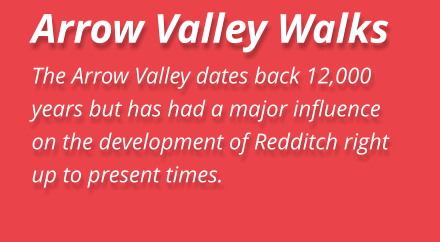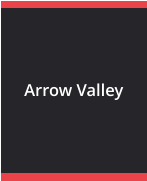




Redditch Walks is part of my Explore Redditch group of websites Designed, maintained and administered by Anthony Green
The Arrow Valley
The Arrow Valley was created during the last (Devensian) ice age around 12,000 years ago and flint tools have been found here indicating that there were people here in the late Neolithic period onwards. Running along the eastern periphery of the Park is the route of Iknield Street, a Roman road, and Ipsley, which lies between the central and southern sections of the park, was mentioned in the Domesday Book. In the 12th Century, Cistercian monks arrived in the northern section of what now is the Arrow Valley Park, diverted the River Arrow, drained the area and built Bordesley Abbey. The monastery lasted for 400 years before the dissolution and the abbey precinct then reverted to rough farmland. The area has never been ploughed or built on and is a valuable archaeologic site. It is a scheduled monument under the Ancient Monuments and Archaeological Areas Act 1979 and was extensively excavated by Reading University in the 1960s and 70s. The Bordesley Abbey Visitor Centre lies within the Forge Mill Museum complex. The introduction of needle manufacture in the Redditch area relied heavily on the water power provided by the River Arrow, particularly for the final scouring (cleaning) process. Along the Arrow within Redditch there were numerous water mills of which evidence of five of them still survives within the area. The most important of these is the National Needle Museum at Forge Mill which was opened by Queen Elizabeth II in 1983. This is of international importance and is the only working water powered scouring mill in the world. The final chapter in the history of the Arrow Valley was the designation of Redditch as a ‘New Town’ in 1964. For the development of Redditch planners had learnt from previous mistakes and the development followed the ideals of the Garden City movement of the early 20th Century. Thus, the Arrow Valley Park was created, with its attractive lake, which provided a ‘green corridor’ passing through the town.Arrow Valley Walks
There are three walks for the Arrow Valley Park. These have been updated for 2018. The walks can be printed two sides on an A4 sheet and then simply folded to provide a convenient A5 document • Arrow Valley North Walk Bordesley Abbey to Papermill • Arrow Valley Central Walk Arrow Valley Lake • Arrow Valley South Walk Arrow Valley Lake to Washford






Redditch Walks is part of my Explore Redditch group of websites
Designed, maintained and administered by Anthony Green













